The project was actually launched in 2004, but only now is construction planning beginning, according to Turkish Ministry of National Defence Shipyards Deputy Director General Rear Admiral (Lower Half) Mehmet Sari, who said recently that specialist teams have been assigned to the submarine program.
The sub’s design will build heavily on technology and information packages obtained from Germany during the two nations’ joint construction of the Type 214 submarine. German firm Howaldtswerke-Deutsche Werft permitted six of the subs, which are also operated by South Korea, Greece and Portugal, to be built at the Turkish Gölcük Naval Shipyard in Kocaeli, using substantial numbers of parts from Turkish subcontractors, Defense News noted.
“The program will be a copy of the German contract,” a naval specialist in Ankara told Defense News for a Tuesday article, noting the 2011 contract was worth $2.8 billion.
However, last week, German Chancellor Angela Merkel announced that German-Turkish contracts would be suspended so long as Ankara’s military operations in eastern Syria continued. On Tuesday, Turkish President Recep Tayyip Erdogan announced an end to that offensive, following his meeting with Russian President Vladimir Putin in the Russian city of Sochi, at which they hammered out a deal for the end of hostilities in the area.
Turkey's up coming naval vessels.
— Kevin Sky🎖️𐱅𐰇𐰼𐰜 𐰶𐰃𐰯𐰲𐰴 (@EmirLouise) May 4, 2019
🔵4 x I class Frigate
🔴7 x TF-2000 Destroyers (166 meters)
🔵6 x Reis class submarines (Type 214)
🔴 Second LHD
🔴Milden National Submarine pic.twitter.com/Pkr0HOzLDB
Navy Recognition noted the first MILDEN submarine is expected to be completed “in the second half of the 2030s,” but dates given by other outlets range from as early as 2030 to as late as 2040. The boat is expected to displace 1,850 tons and have an air-independent propulsion (AIP) system powered by hydrogen fuel cells, enabling it to stay submerged for weeks at a time - much longer than traditional diesel submarine batteries but not nearly the duration of nuclear-powered subs, which need never surface except to disembark submariners and take on supplies.
“Contrary to popular belief, AIP is used to power the electric motor which turns the propeller, not to charge the batteries,” Forbes noted on Monday. “The batteries are reserved for silent running and high-speed dashes when the AIP alone is not enough.”
Turkey has the second-largest submarine fleet in the NATO alliance, second only to the United States. However, thanks to the 1936 Montreux Convention, no other country’s submarines are permitted to pass through the Bosporus Strait, which serves as the only maritime outlet for the Black Sea, giving Turkey a unique advantage.
Submarines aren’t the only indigenously designed piece of military hardware under development by Ankara, though: at the Paris Air Show in June, Turkey unveiled its TF-X fifth-generation jet, the country’s answer to the F-35, which Washington has now barred Turkey from acquiring due to its purchase of Russian S-400 air defense systems.

